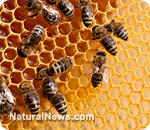Colony Collapse Disorder in bees triggered not just by pesticides, but also by GMO high-fructose corn syrup

(NaturalNews) Studies linking neonicotinoid pesticides to Colony Collapse Disorder (CCD), a condition in which entire bee colonies suddenly disappear or die, have been gaining national attention in recent months as they continue to flood scientific journals. But one area that has been largely overlooked is the role high-fructose corn syrup (HFCS) plays in killing off bees, as the vast majority of it comes from genetically-modified (GM), pesticide treated corn crops.
Chensheng Lu, Kenneth M. Warchol, and Richard A. Callahan from theDepartment of Environmental Healthat theHarvard School of Public Healthexamined the effects of imidacloprid, a neonicotinoid pesticide, on bee colonies as part of a recent review. Part of this research involved using HFCS that had been derived from corn crops treated with imidacloprid, for which the pesticide ended up getting into the end product.
For their study, the team created four honey bee sites with five honey bee hives each, for a total of 20 hives, with each site containing four imidacloprid hives and a control hive. Among the 16 hives treated with imidacloprid, varying amounts of the pesticide were used in order to gain a proper assessment of how, and at what levels, it affects bees.
In the end, the team discovered that the vast majority -- 94 percent -- of hives treated with imidacloprid ended up dying off as a result of what appeared to be CCD, even when very minute levels of the pesticide were added. And a key culprit in this die-off was imidacloprid-tainted HFCS, which served as the delivery system for this toxic chemical.
"Data from thisin situstudy provide convincing evidence that exposure to sub-lethal levels of imidacloprid in HFCS causes honey bees to exhibit symptoms consistent to CCD 23 weeks post imidacloprid dosing," wrote the authors. "15 or 16 imidacloprid-treated hives (94%) were dead across four apiaries 23 weeks post imidacloprid dosing."
You can review the study for yourself at:
http://www.bouldercountybeekeepers.org
Most commercial honey comes from bees fed chemical-laden HFCS
HFCS is commonly fed to many commercial bees today, which is why more than 75 percent of the so-called "honey" sold on store shelves is nothing more than HFCS (http://www.naturalnews.com/034102_honey_consumer_alert.html). And since the GM corn crops from which the vast majority of HFCS is derived have been treated with imidacloprid and other pesticides, it is hardly surprising that these chemicals end up in commercial bee feed.France actually banned the use of imidacloprid on sunflowers and sweet corn back in 1999 and 2003, respectively, after more than one third of its bees died (http://www.guardian.co.uk). And yet the pesticide continues to be used in the U.S., despite the fact that it was never even lawfully approved for use by theU.S. Environmental Protection Agency(EPA).
Sources for this article include:
http://www.bouldercountybeekeepers.org
http://www.humanespot.org
Learn more:http://www.naturalnews.com/035610_honey_bees_pesticides_corn_syrup.html#ixzz1sU8qgBcE

No comments:
Post a Comment